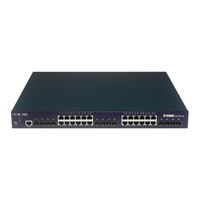D-Link xStack DGS-3610 Series Switch Manuals
Manuals and User Guides for D-Link xStack DGS-3610 Series Switch. We have 3 D-Link xStack DGS-3610 Series Switch manuals available for free PDF download: Configuration Manual, Hardware Installation Manual, Quick Installation Manual
D-Link xStack DGS-3610 Series Configuration Manual (703 pages)
Table of Contents
-
-
Command Mode31
-
-
-
-
-
-
Overview93
-
-
-
Overview99
-
Supported VLAN100
-
VLAN Member Type100
-
-
Configuring VLAN100
-
Showing VLAN105
-
-
-
-
-
-
-
-
Overview149
-
-
-
-
MSTP Overview175
-
STP and RSTP175
-
MSTP Overview184
-
-
Configuring MSTP193
-
-
-
Overview209
-
Precautions209
-
-
SPAN Session210
-
Frame Type210
-
Source Port211
-
Destination Port211
-
SPAN Traffic211
-
Configuring SPAN211
-
-
-
-
Configuring DHCP231
-
-
Overview243
-
Configuring DHCP245
-
-
-
Unerstanding NTP257
-
Configuring NTP257
-
-
-
-
Overview269
-
SNMP Security272
-
SNMP Engine ID273
-
-
-
-
-
Overview287
-
Statistics287
-
History287
-
Alarm288
-
Event288
-
-
-
-
RIP Overview293
-
-
-
-
OSPF Overview307
-
-
-
-
-
-
-
-
Overview423
-
-
-
-
Overview457
-
PIM-SM Overview463
-
-
Enabling IGMP467
-
-
-
Configuring IGMP469
-
-
-
Storm Control497
-
Protected Port499
-
Port Security501
-
-
-
Overview509
-
-
Authorization533
-
-
-
Method List546
-
-
-
About SSH569
-
SSH Support569
-
-
-
-
Overview581
-
-
-
-
-
Security Agent589
-
Restore System589
-
Security Switch590
-
-
-
-
Configuring DAI597
-
-
Overview601
-
-
-
QOS Overview625
-
Configuring QOS629
-
QOS Display638
-
-
-
-
Route Redundancy645
-
Load Balancing645
-
-
-
-
Show Vrrp650
-
Debug Vrrp652
-
-
-
-
About RLDP661
-
Configuring RLDP664
-
Advertisement
D-Link xStack DGS-3610 Series Quick Installation Manual (6 pages)
Brand: D-Link
|
Category: Network Router
|
Size: 0 MB
Table of Contents
Advertisement
Advertisement


